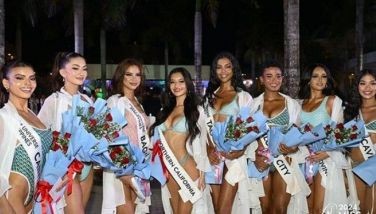The Glorious Sampaguita Days

Without fanfare, Sampaguita Pictures, Inc. (SPI) turned Diamond on Dec. 27 last year, the same date 75 years ago when it released Bituing Marikit, the company’s maiden production directed by Carlos Vander Tolosa and starring Elsa Oria (then dubbed as “The Singing Sweetheart of the Philippinesâ€) with Rogelio dela Rosa and Ely Ramos. It was shown from Dec. 27, 1937 to Jan. 11, 1938 at the Grand Theater. Barely 20 years later, the movie was remade, with Amalia Fuentes, Juancho Gutierrez and Daisy Romualdez.
It was Funfare’s “other beauty expert†Celso de Guzman Caparas who dug up this interesting information, including these:
= One of the SPI founders was Hon. Judge Jose Olfinas Vera who held various government positions: Senator of the Philippines in the Seventh Legislature (1925-1928), under the Sixth Senatorial District of Albay, Sorsogon, Camarines Norte, Camarines Sur and Masbate; Governor of Albay; and a Judge ad interim of the seventh branch of the Court of First Instance of Manila. He was also the Nacionalista Party campaign manager in the 1946 presidential election.
= From 1937 to the onset of the Pacific War, Sampaguita released 43 films, the last one being Landas na Ginto, shown from Dec. 26, 1942, to Jan. 9, 1943 at Dalisay Theater.
= The pre-war era saw the emergence of the Carmen Rosales and Rogelio dela Rosa love team in Takip-Silim, shown from Dec. 28, 1939, to Jan. 5, 1940, at the Grand Theater, followed by Señorita, Lambingan, Diwa ng Awit and Colegiala (all in 1940), to name a few.
Celso noted that while still reeling from the destruction wrought by the war, SPI resumed production after the Liberation and its first post-war film was Ulila ng Watawat (Dedicated to the Dead and Living Heroes of the Philippines), shown on May 31 until June 11, 1946 at Dalisay Theater, with Elsa Oria and Jose Padilla Jr. in the lead roles and directed by Octavio Silos. Three more movies about the war were released in 1946: Gerardo de Leon’s So Long, America (I’ll Be Seeing You Everywhere) starring Fely Vallejo and Angel Esmeralda, introducing Fred Montilla; Octavio Silos’ Guerilyera (with Carmen Rosales in the title role and Tita Duran, her first grown-up role) and Lorenzo P. Tuells’ Maynila (topbilled by Corazon Noble, Ely Ramos and Tita Duran). A number of budding stars were introduced including, Guia Imperial and Francisco Monroy in Dahil sa Ina (1947) and Eduardo “Eddie†del Mar in Ang Kapilya sa Daang Bakal (1947).
“In a 1949 nationwide poll among movie fans by Ilang-Ilang magazine,†wrote Celso, “Tita Duran and Pancho Magalona won Most Popular Actress and Actor of 1948, and Most Popular Love Team of 1948. The couple’s film, Dahil Sa Iyo, was voted Best Picture of 1948.â€
Other stars who made films between circa ‘30s and ‘40s were Rosario Moreno, Carlos Padilla, Norma Blancaflor, Leopoldo Salcedo, Gregorio Fernandez, Pacita del Rio, Naty Bernardo, Gregorio Fernandez, Linda Estrella, Lota Delgado, Lilian Leonardo, Paraluman, Maria Cristina, Rosa Aguirre, Roberto Rosales, Alicia Vergel, Nita Carmona, then child star Liberty Ilagan, Miguel Anzures, Teddy Benavidez, Pacita del Rio, Tito Arevalo, Fernando Royo, Bert Le Roy, Vicente Liwanag, Preciosa Palma, Danilo Montes, Jaime Castellvi, Jose Cris Soto, Teresita Martinez, Rosie Lorenzana, Pedro Faustino, Norma Vales, Chichay, Tolindoy, Aruray and boxing champ Tirso del Rosario, among others.
Tragedy struck on Jan. 4, 1951, when the studio was razed by a fire, leaving an estimated loss of more than P5M (a fortune at that time).
According to Celso’s research, aside from vaults of films from 1937 to 1951, also burned were the 13 rolls of negatives of Ang Kasaysayan ni Dr. Ramon Selga, scheduled to be shown a week after at the Life Theater; only two rolls were rescued.
“Luckily,†added Celso, “the cameras, laboratory and prop equipment were saved so Dr. Ramon Selga was reshot day and night, with all the employees volunteering to do extra work. The film was shown from Jan. 30 to Feb. 9, 1951.â€
Of course, what greatly helped put the studio back on its feet was the tearjerker Roberta, starring child star Tessie Agana (daughter of SPI actress Linda Estrella), introducing child actor Boy Alano and Tony Cayado (later became a director), from a story by Mars Ravelo and directed by Olive La Torre. A grand premiere night sponsored by the Philippine Movie Press Club was held on Feb. 28, 1951 at the Life Theater with Sampaguita stars gracing in full force. As an expression of sympathy, stars from nine other film outfits attended: LVN, Premiere, Lebran, Royal, Nolasco, Balintawak, Benito Bros., Liwayway and Filcudoma.
This kind of pakikisama has never been duplicated in the industry which is now divided by extreme competition and the network war among TV stations.
Continued Celso, “Touted as The Shirley Temple of the Philippines, Tessie was escorted to the theater by a 12-unit Quezon City motorcycle police escorts. The event was recorded for broadcast throughout the country over DZBB. Roberta opened its regular run on March 2, 1951, and was a big blockbuster not only in Manila but also in Cebu, Bacolod, Iloilo and Baguio, breaking all standing box-office records during its entire exhibition. Roberta literally rebuilt the company from the ashes.â€
Furthermore, the movie won several Maria Clara Awards in 1951: Judge Vera, Best Producer; Tessie Agana, Best Child Actress; and Rosa Mia, Best Supporting Actress.
Following the death of Judge Vera on Aug. 15, 1956, his wife Dolores Morato Honrado-Vera, fondly called Mommy Vera, took over the stewardship of the company assuming the positions of president and executive producer. She introduced the “morality clause†in the stars’ contracts wherein stars who didn’t conform to the moral standards were either suspended or expelled depending on the gravity of the case. In recognition of her commendable efforts, Mommy Vera received a Presidential Medal of Merit and Citation from Pres. Carlos P. Garcia, citing the company for depicting “family ideals and moral values through the movies.â€
A year after, a sister film outfit was established, the Vera Perez Pictures. Both SPI and VPP were managed by Dr. Jose Perez, fondly called Doc Perez and tagged as The Star Builder. He was the husband of Azucena “Mama Nene†Vera Perez, the only daughter of Judge and Mrs. Vera. They have seven children namely Maria Azucena (Marichu or Manay Ichu), Pepito, Georgina (now Mrs. Joe de Venecia or Manay Gina), Bobby (who died at the age of 26), Lilibeth (now Mrs. Nakpil), Chona (now Mrs. Ampil) and Jose Gregorio (Kokoy).
VPP’s first opening was Sino Ang Maysala? (released on March 7, 1957), topbilled by SPI prized stars: Rogelio dela Rosa, Gloria Romero, Paraluman, Ric Rodrigo, Lolita Rodriguez, Luis Gonzales, Rosa Mia, Susan Roces and Romeo Vasquez; Greg Martin was introduced. It was directed by Armando Garces from a serialized story written by Dr. Fausto J. Galauran in Liwayway magazine. After a year, a follow-up movie, Ako Ang Maysala! with Romeo Vasquez won the Asia Film Festival Best Actor for 1958.
Circa 1950s, other SPI stars included Eddie Garcia, Cesar Ramirez, Myrna Delgado, Bella Flores, Ramon Revilla, Rita Gomez, Katy dela Cruz, Joan Page, Dolphy, Panchito, Eddie Arenas, Nelly Baylon, Tito Galla, Juancho Gutierrez, Barbara Perez, Tita Muñoz, Tony Marzan, Marlene Dauden, child star Rosemarie, Eddie Gutierrez, Jose Mari, Zeny Zabala, Pacita Arana, Van de Leon, Georgie Quizon, Rod Navarro, Nancy Carlos, Lilian Laing and the Vera-Perez siblings Pepito and Lilibeth, among others.
The ‘60s saw the launching of Stars ’66 (Rosemarie, Gina Pareño, Blanca Gomez, Loretta Marquez, Shirley Moreno, Pepito Rodrigruez, Ramil Rodriguez, Bert Leroy Jr., Dindo Fernando and Edgar Salcedo); child actresses Vilma Santos and Connie Angeles, Vic Vargas, Ricky Belmonte, German Moreno, beauty queens Cynthia Ugalde and Josephine Estrada, Jean Lopez, Jeanne Young and Ace York (later known Ace Vergel), among them.
A muse was selected by the Sampaguita Family Club and crowned during its annual affair held towards the end of the year, among them Gloria Romero, Susan Roces, Jean Lopez, Josephine Estrada, Rosemarie, Naty Santiago, Liberty Ilagan and Nora Aunor who broke the “mestiza standard.â€
Goriong Butete, with Chiquito and Amy Austria, was the last offering of the company, released on May 9, 1980. Mommy Vera passed away a week after, on May 15.
Manay Ichu put up MVP Productions which had three outputs: Elwood Perez’s Stepsisters (1979, with Lorna Tolentino and Rio Locsin in the title role) and Pakawalan Mo Ako (with Vilma Santos, FAMAS Best Actress for 1981; opposite Christopher de Leon and Anthony Castelo) and Mike de Leon’s Batch ’81 starring Mark Gil, Sandy Andolong, Ward Luarca, Noel Trinidad, Charito Solis, Dang Cecilio, Johnny Delgado and Chanda Romero (the first Film Academy of the Philippines Best Picture for 1982). Then film production folded up.
With the help of archivists and editors, Lilibeth Perez-Nakpil took charge of the archives collection and its preservation, which is composed of over a hundred black and white and colored films, advertising layouts, magazine articles and various paraphernalia.
A big portion of the Sampaguita Studio is now being converted into a Sampaguita Garden, a venue for social events such as birthdays, weddings, debuts and the like.
(E-mail reactions at [email protected]. You may also send your questions to [email protected].)
- Latest
- Trending































